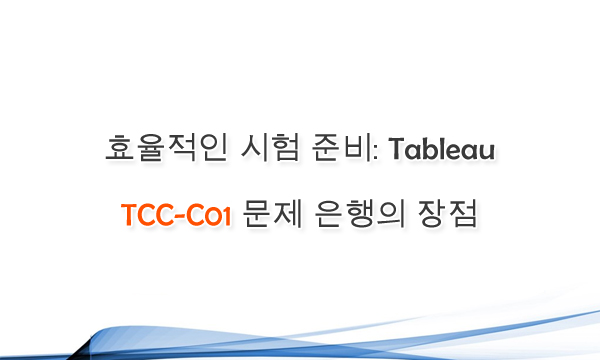효율적인 시험 준비: Tableau TCC-C01 시험 은행이 최선의 선택입니다-siheom
TCC-C01인증시험덤프 Tableau 자격증 시험 준비를 더 잘하고 싶으신가요? 저희는 고품질의 Tableau 자격증 TCC-C01 문제집을 제공합니다. 이 문제집은 Tableau TCC-C01 시험의 중요한 주제를 다루도록 설계되었습니다. 이 문제집을 학습하면 시험 개념에 대한 이해가 크게 향상될 것입니다. 특히 약한 개념을 강화하는 데 유용하며, 시험에 응시하기 전에 철저히 준비할 수 있도록 도와줍니다. 이는 자신감을 높여줄 뿐만 아니라 Tableau 자격증 시험에 합격할 가능성을 크게 높여줍니다.
Tableau 공인 컨설턴트 인증은 Tableau 플랫폼 내에서 분석 솔루션 설계를 주도하기 위해 고객과 소통하는 개인을 위한 것입니다. 프로젝트의 범위는 사업부 수준이 아닌 경영진 수준으로 지정될 수 있습니다. 분석을 위한 장기적이고 전략적인 권장 사항을 제공하고 복잡한 성능 문제를 독립적으로 처리합니다. 매우 복잡한 데이터 문제를 해결합니다.

이 자격 증명은 Tableau Prep, Desktop, Cloud, Server 및 Bridge를 비롯한 다양한 Tableau 제품을 사용해야 하는 직원, 파트너, 고객 및 프리랜서의 핵심 Tableau 지식과 실무 개발 기술을 모두 검증합니다. 시험에 대한 전제 조건은 없습니다. 이 시험을 성공적으로 완료하면 응시자는 Tableau 공인 컨설턴트라는 타이틀을 받게 됩니다. 이 타이틀은 2년 동안 유효합니다.
대상 설명: Tableau 공인 컨설턴트
이 시험의 응시자는 Tableau 플랫폼 내에서 분석 솔루션의 설계를 주도하기 위해 고객과 협력합니다. 매우 복잡한 데이터 문제를 해결할 수 있습니다. 프로젝트의 범위는 사업부 수준이 아닌 경영진 수준으로 지정될 수 있습니다. 분석을 위한 장기적이고 전략적인 권장 사항을 제공하고 복잡한 성능 문제를 독립적으로 처리합니다.

컨설턴트는 일반적으로 Tableau Prep, Desktop, Cloud, Server 및 Bridge를 포함한 Tableau 및 Tableau 제품에 대한 최소 1년의 경험을 갖고 있으며 최소 2번의 구현에 참여했습니다. 컨설턴트는 TDS(Tableau Desktop Specialist) 및 TCDA(Tableau Certified Data Analyst) 인증 시험을 통과할 수 있는 기술을 보유하고 있습니다. 이번 시험은 해당 기술의 발전입니다. 응시자는 TDS 및 TCDA 시험에서 다루는 역량을 보유하고 있는 것으로 간주되므로 TDS 및 TCDA 시험 수준에서 시험을 치르지 않습니다.
시험 개요
지식 기반: 40-45개의 객관식 및 객관식 항목
성과 기반: 6~8개의 실습 랩 작업
제한 시간: 120분(NDA 검토 3분, 튜토리얼 5분 포함)
제공 언어: 영어
합격 점수: 750
전제 조건: 필요하지 않음
등록비: USD $250 + 현지 법률에서 요구하는 관련 세금
시험 개요
도메인 1: 현재 상태 평가 28%
1.1 분석의 현재 상태를 미래 상태에 매핑
1.1.1 볼륨, 격차 분석, 성능 및 데이터 정확성을 포함한 기존 보고서를 평가합니다.
1.1.2 기존 보고서, 데이터 제품 및 비즈니스 요구 사항을 Tableau 기능에 매핑
1.1.3 모범 사례를 사용하여 분석 요구 사항을 Tableau 컨텍스트로 변환
1.1.4 마이그레이션을 포함하여 Tableau Server 또는 Tableau Cloud 사용 여부 권장
1.2 현재 데이터 구조 평가
1.2.1 기존 데이터가 비즈니스 요구 사항을 지원하는지 평가
1.2.2 기존 데이터 구조의 계보 평가
1.2.3 기존 데이터 구조의 성능 위험을 평가합니다.
1.2.4 성능 향상 기회를 위해 기존 데이터 구조를 평가합니다.
도메인 2: 데이터 연결 계획 및 준비 19%
2.1 데이터 변환 계획
2.1.1 적절한 데이터 저장 방식, 데이터 구조, 전략 추천
2.1.2 Tableau Desktop, Tableau Prep 또는 ETL 제품을 포함하여 데이터 변환에 적합한 도구 추천
2.1.3 Tableau Prep 및 Tableau 통합 문서에서 정적 및 반응형 계산의 영향 식별
2.1.4 최소 수준의 세분성에 대한 요구 사항 지정
2.2 행 수준 보안(RLS) 데이터 구조 설계
2.2.1 RLS 및 자격 테이블 구현
2.2.2 그룹 기능과 사용자 기능 식별
2.2.3 RLS를 지원하는 계층 구조 구현
2.2.4 RLS 접근법 비교
2.3 데이터에 대한 고급 연결 계획 및 구현
2.3.1 웹 데이터 커넥터, 웹 추출 API, 사용자 정의 SQL, ODBC 등 데이터에 연결하는 적절한 방법을 권장합니다.
2.3.2 Tableau Bridge를 사용하여 연결 만들기
2.3.3 형성 및 결합을 포함하여 특정 요구 사항을 충족하기 위해 데이터를 준비하는 방법을 권장합니다.
2.3.4 Tableau 제품(Tableau Desktop, Tableau Prep, Tableau Cloud, Tableau Server)의 데이터 원본에 대한 집계 수준 및 전략 지정
2.3.5 분석에 필요한 최소 필드 식별
2.3.6 복잡한 데이터 문제 및 연결 문제 해결
도메인 3: 계산 및 통합 문서 설계 및 문제 해결 39%
3.1 고급 사용 사례를 위한 설계 분석
3.1.1 Sankey, Chord, Radar, Tile Map, Small Multiples, Data Densification 등 고급 차트 유형을 사용하는 경우 권장
3.1.2 맞춤형 차트에 필요한 계산 계획 및 구현
3.1.3 Tableau 작업 순서가 계산에 미치는 영향을 식별합니다.
3.1.4 Tableau 작업 순서로 인해 발생하는 문제 해결
3.1.5 동적 URL 작업, 매개 변수 작업, 필터 작업, 시트 교환 등 대시보드에 상호 작용 기능을 구축하기 위한 고급 기술을 계획하고 구현합니다.
3.1.6 데이터에 질문(Ask Data), 데이터 설명(Explain Data), 데이터 스토리(Data Stories) 등 증강 분석의 사용 사례 식별
3.2 성능 최적화를 위한 통합 문서 디자인
3.2.1 자원 의도 식별 및 해결
활발한 쿼리
3.2.2 Tableau Server의 캐싱 최대화
3.2.3 문자열 비교, IF THEN 문, 세부 수준(LOD) 식 등 계산으로 인해 발생하는 성능 문제 식별 및 해결
3.2.4 Tableau 업스트림으로 이동해야 하는 계산 권장
3.2.5 성능 기록을 사용하여 문제 해석 및 해결
3.2.6 시트 수, 필터 수, 이미지 크기 등 설계 요소로 인해 발생하는 성능 문제를 식별하고 해결합니다.
3.3 여러 단계를 포함하는 고급 계산 구현
3.3.1 차원을 포함하는 집계 구현
3.3.2 창, 중첩 테이블, 다방향 등 고급 테이블 계산 구현
3.3.3 회계 달력과 같은 고급 날짜 기능 구현
3.3.4 중첩된 LOD와 같은 고급 LOD 구현
3.3.5 고급 계산 조합 구현
3.3.6 고급 계산 문제 해결
도메인 4: 거버넌스 확립 및 게시된 콘텐츠 지원 14%
4.1 Tableau 거버넌스 전략 권장 및 적용
4.1.1 조직의 거버넌스 요구 사항을 Tableau 기능 및 성능에 매핑
4.1.2 콘텐츠에 대한 접근권 확보 전략 추천
4.1.3 기능별, 조직별, 역할별 등 콘텐츠 구성 전략 추천
4.1.4 데이터 소스 인증, 데이터 확산 최소화, 데이터 품질 경고 구성 등 데이터 품질 보장을 위한 전략 권장
4.1.5 데이터 계보를 포함한 데이터 카탈로그를 사용하여 거버넌스 전략의 준수 여부를 평가합니다.
4.2 사용자 정의 관리 뷰 디자인
4.2.1 리포지토리 스키마 및 이벤트 유형 해석
4.2.2 사용자 정의 관리 보기가 필요한 통찰력 지정
4.2.3 관리 뷰를 생성하기 위한 적절한 권한 지정
4.3 콘텐츠 유통 전략 추천
4.3.1 게시 요구 사항을 Tableau의 기능에 매핑
4.3.2 구축, 테스트, 배포, 배포, 유지 관리를 포함한 통합 문서 수명 주기에 대한 접근 방식 권장
4.3.3 Tableau 내 버전 제어 전략 권장
4.4 Tableau 외부 오류 식별 및 해결
4.4.1 연결 인증 및 네트워크 액세스 식별 및 해결
4.4.2 소스 시스템에서 발생한 업데이트 실패 식별 및 해결
4.4.3 플랫폼 또는 네트워크 중단 등 Tableau 외부에서 발생하는 기타 문제 식별

Tableau Certified Consultant TCC-C01 시험덤프자료
1. A client has many published data sources in Tableau Server. The data sources use the same databases and tables. The client notices different departments give different answers to the same business questions, and the departments cannot trust the data. The client wants to know what causes data sources to return different data.
Which tool should the client use to identify this issue?
A. Tableau Prep Conductor
B. Ask Data
C. Tableau Catalog
D. Tableau Resource Monitoring Tool
Answer: C
2. A client has a published data source in Tableau Server and they want to revert to the previous version of the data source. The solution must minimize the impact on users.
What should the consultant do to accomplish this task?
A. Request that a server administrator restore a Tableau Server backup.
B. Delete and recreate the data source manually.
C. Select a previous version from Tableau Server, download it, and republish that data source.
D. Select a previous version from Tableau Server, and then click Restore.
Answer: D
3. A Tableau Cloud client has requested a custom dashboard to help track which data sources are used most frequently in dashboards across their site.
Which two actions should the client use to access the necessary metadata? (Choose two)
A. Connect directly to the Site Content data source within the Admin Insights project.
B. Query metadata through the GraphiQL engine.
C. Access metadata through the Metadata API.
D. Download metadata through Tableau Catalog.
Answer: B, C
4. A client notices that while creating calculated fields, occasionally the new fields are created as strings, integers, or Booleans. The client asks a consultant if there is a performance difference among these three data types.
What should the consultant tell the customer?
A. Strings are fastest, followed by integers, and then Booleans.
B. Integers are fastest, followed by Booleans, and then strings.
C. Strings, integers, and Booleans all perform the same.
D. Booleans are fastest, followed by integers, and then strings.
Answer: B
5. A new Tableau user created a simple dashboard on Tableau Server using supply chain data. Now, the user wants to know if they created the dashboard in accordance with specific performance best practices.
Which approach should the consultant recommend for the client to make this determination?
A.Use inbuilt dashboards in Tableau Server to troubleshoot the performance.
B.Use Performance Recording on Tableau Server.
C.Use Performance Recording in Tableau Desktop.
D.Run Workbook Optimizer.
Answer: D

6. A client requests a published Tableau data source that is connected to SQL Server. The client needs to leverage the multiple tables option to create an
extract. The extract will include partial data from the SQL Server data source.
Which action will reduce the amount of data in the extract?
A.Use an extract filter.
B.Aggregate the extract to the visible dimensions.
C.Define the filters by using custom SQL.
D.Set up the extract as an incremental refresh.
Answer: A
7. A consultant is designing a dashboard that will be consumed on desktops, tablets, and phones. The consultant needs to implement a dashboard design that provides the best user experience across all the platforms.
Which approach should the consultant take to achieve these results?
A.Build one dashboard that has desktop, tablet, and phone layouts, and fix the size of the layouts.
B.Build one dashboard and fix the size of the dashboard.
C.Build one dashboard and set the size to Automatic.
D.Build one dashboard for each type of device and fix the size of the layouts.
Answer: A
8. A client has a published dashboard. They change the dashboard and then republish it. Now, usersreport that their web browser bookmarks to the dashboard are broken.
What are two possible causes for this issue? (Choose two)
A.New credentials were embedded into the data source.
B.The dashboard was published to a different project.
C.Tableau Server was upgraded.
D.The dashboard was published with a new name.
Answer: B, D
9. A client builds a dashboard that presents current and long-term stock measures. Currently, the data is at a daily level. The data presents as a bar chart that presents monthly results over current and previous years. Some measures must present as monthly averages.
What should the consultant recommend to limit the data source for optimal performance?
A. Move calculating averages to data layer and aggregate dates to monthly level.
B. Limit data to current and previous years and leave data at daily level to calculate the averages in the report.
C. Limit data to current and previous years, move calculating averages to data layer, and aggregate dates to monthly level.
D. Limit data to current and previous years as well as to the last day of each month to eliminate the need to use the averages.
Answer: C
10. A consultant creates a histogram that presents the distribution of profits across a client's customers. The labels on the bars show percent shares. The consultant used a quick table calculation to create the labels.
Now, the client wants to limit the view to the bins that have at least a 15% share. The consultant creates a profit filter but it changes the percent labels.
Which approach should the consultant use to produce the desired result?
A.Use a calculation with TOTAL() function instead of a quick table calculation.
B.Add the [Profit] filter to the context.
C.Filter with a table calculation WINDOW_AVG(MIN([Profit]), first(), last())
D.Filter with the table calculation used to create labels.
Answer: B
Tableau TCC-C01 문제 연습, 시험의 문제와 답변을 미리 파악
시험: Tableau Certified Consultant
Tableau TCC-C01 험의 최신 실제 문제와 답안, 합계55개
1년 무료 갱신 | 100%진실 | 100%합격 | 불합격된 100%전액 환불

